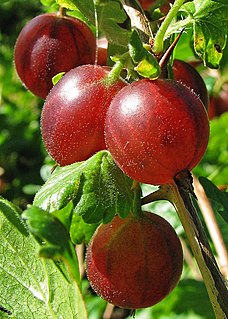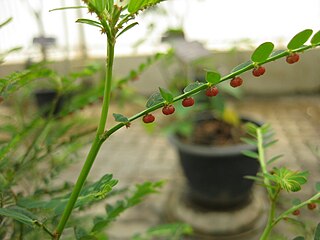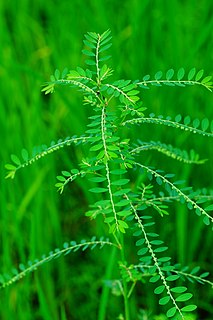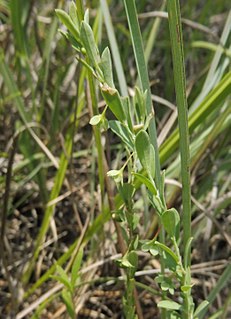
Gooseberry, is a common name for many species of Ribes and other species of plants. The berries of those in the genus Ribes are edible and may be green, red, purple, yellow, white, or black.

Phyllanthus is the largest genus in the flowering plant family Phyllanthaceae. Estimates of the number of species in this genus vary widely, from 750 to 1200. Phyllanthus has a remarkable diversity of growth forms including annual and perennial herbs, shrubs, climbers, floating aquatics, and pachycaulous succulents. Some have flattened leaflike stems called cladodes. It has a wide variety of floral morphologies and chromosome numbers and has one of the widest range of pollen types of any seed plant genus.

Phyllanthaceae is a family of flowering plants in the eudicot order Malpighiales. It is most closely related to the family Picrodendraceae.

Phyllanthus urinaria, commonly called chamber bitter, gripeweed, shatterstone, stonebreaker or leafflower, is a herb species in the family Phyllanthaceae.
Andrachne is a genus of flowering plants in the family Phyllanthaceae described by Linnaeus in 1753. It is one of eight genera in the tribe Poranthereae.

Breynia is a plant genus in the family Phyllanthaceae, first described in 1776. It is native to Southeast Asia, China, the Indian Subcontinent, Papuasia, Australia, and the island of Réunion.

Glochidion is a genus of flowering plants, of the family Phyllanthaceae, known as cheese trees or buttonwood in Australia, and leafflower trees in the scientific literature. It comprises about 300 species, distributed from Madagascar to the Pacific Islands. Glochidion species are used as food plants by the larvae of some Lepidoptera species including Aenetus eximia and Endoclita damor. The Nicobarese people have attested to the medicinal properties found in G. calocarpum, saying that its bark and seed are most effective in curing abdominal disorders associated with amoebiasis.
Phyllanthus gentryi is a species of plant in the family Phyllanthaceae. It is endemic to Panama. It is threatened by habitat loss.
Phyllanthus pavonianus, synonym Phyllanthus haughtii, is a species of plant in the family Phyllanthaceae. It is native from south Ecuador to north-west Peru. Its natural habitat is subtropical or tropical moist montane forests. Under the synonym Phyllanthus haughtii, it has been regarded as "endangered".
Phyllanthus profusus is a species of plant in the family Phyllanthaceae. It is found in Ghana, Guinea, and Liberia. It is threatened by habitat loss.
Sauropus assimilis is an extremely rare species of plant in the family Phyllanthaceae. It is a tree growing in wet evergreen forests in lowlands. Endemic to southwestern Sri Lanka, and only known from the Sinharaja Biosphere Reserve there, evidence of its existence was last catalogued before 1991, and it has not been found since then. It may since have become extinct.

Phyllanthus microcladus is a plant found in sub tropical areas of eastern Australia. The brush sauropus is listed as endangered by extinction. It occurs by streams in sub tropical rainforest, from as far south as Grafton, New South Wales to the south east rainforest areas of Queensland. Most often seen in the valleys of the Brunswick, Richmond and Tweed Rivers in far north eastern New South Wales.

Epicephala is a genus of moths in the family Gracillariidae.

Phyllanthus niruri is a widespread tropical plant commonly found in coastal areas, known by the common names gale of the wind, stonebreaker or seed-under-leaf. It is a relative of the spurges, belonging to the genus Phyllanthus of the family Phyllanthaceae.

Phyllanthus polygonoides, known as smartweed leaf-flower or knotweed leafflower, is an herbaceous perennial plant in the family Phyllanthaceae. It grows from 10 to 50 centimeters in height. It is native to the United States and northern and central Mexico.

Phyllanthus reticulatus is a plant species described Jean Louis Marie Poiret; it is included in the family Phyllanthaceae.
Jeremy James Bruhl is an Australian botanist. He is a professor in the School of Environmental and Rural Science at the University of New England and director of the N.C.W. Beadle Herbarium which holds c.100,000 plant specimens.

Phyllanthus calycinus, known as false boronia and snowdrop spurge, is a small shrub in the family Phyllanthaceae, which grows to heights from 20 cm to 1.2 m, often on sandy soils. It is found in both Western Australia and South Australia. In Western Australia its white-cream to pink flowers may be seen from June to January, and in South Australia, from May to October.

Sauropus arenosus is a plant in the family Phyllanthaceae, native to Western Australia and the Northern Territory.













